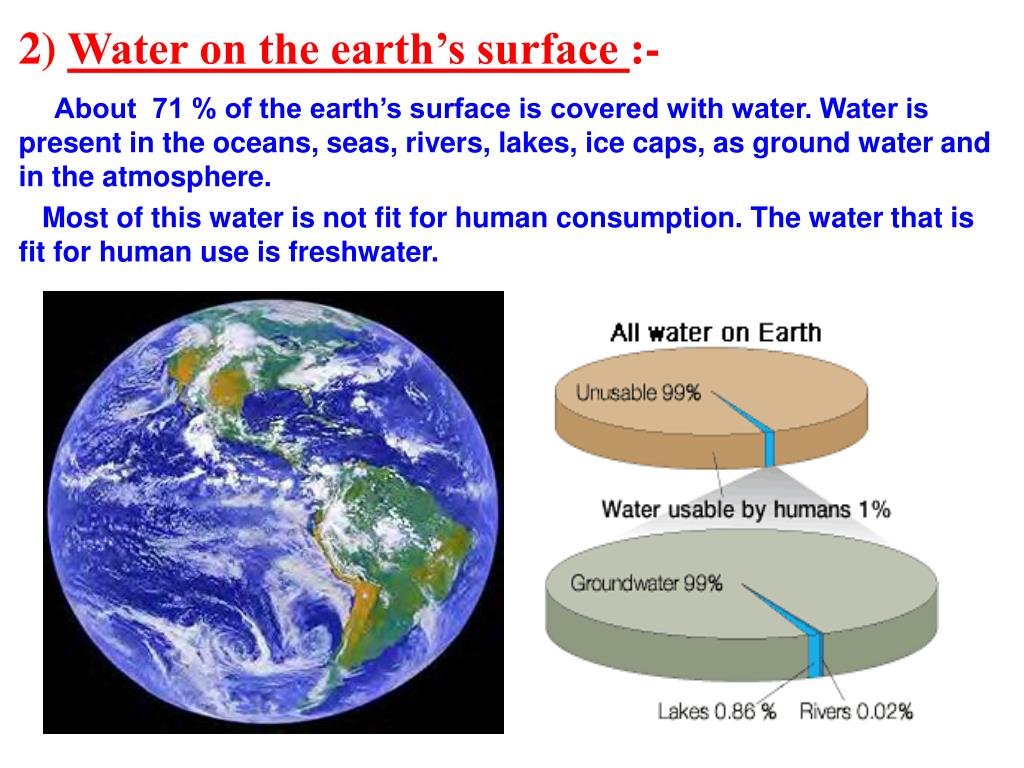The surface of the earth is about 60 water and 10 ice

The Surface of the Earth: A World Dominated by Water and Ice

The surface of the Earth is a mesmerizing place, full of diverse landscapes and breathtaking views. As we explore this vast planet, we come to realize that water plays a crucial role in shaping our environment. In fact, approximately 70% of the Earth’s surface is covered in water, making it the most abundant resource on our planet. Fascinatingly, out of this 70%, about 60% exists as liquid water, while the remaining 10% is in the form of ice. This fact highlights the significance of water and its presence in various states across our planet.

As we delve deeper into this fact, let’s explore the role water plays in shaping the Earth’s surface and the impact of ice on our planet’s overall composition.
The Dominance of Liquid Water
Liquid water covers approximately 60% of the Earth’s surface, forming vast oceans, seas, lakes, and rivers. This immense quantity of water is crucial for supporting life on our planet, as it provides a habitat for countless marine species and nourishes terrestrial ecosystems. Moreover, these bodies of water act as natural highways, enabling trade and transportation between nations across the globe.
The oceans, in particular, hold an enigmatic charm and cover about 71% of the Earth’s surface area. These vast bodies of water are teeming with life, hosting a diverse array of ecosystems and supporting a broad spectrum of marine organisms. The oceans also play a critical role in regulating the Earth’s climate by absorbing and releasing heat, thereby influencing weather patterns and controlling temperature variations.
The Icy Extremities
While liquid water dominates a significant portion of the Earth’s surface, the presence of ice is equally remarkable. Approximately 10% of the Earth’s surface is covered by glaciers, ice caps, and ice sheets. These frozen expanses exist in polar regions and lie predominantly in Antarctica and Greenland.
Ice acts as a record keeper of our planet’s climatic history, preserving information on atmospheric composition and temperature fluctuations over thousands of years. Its presence is crucial for maintaining a balance in the Earth’s climate system, regulating sea levels, and reflecting solar radiation back into space.
Water’s Endless Cycle
The Earth’s water cycle is a continuous process that includes the evaporation of liquid water, condensation to form clouds, precipitation, and runoff back into bodies of water. This intricate cycle ensures the availability of fresh water for both terrestrial and aquatic ecosystems and plays an essential role in global weather patterns.
Water sustains life in multiple ways, from providing a vital resource for human consumption to nurturing vegetation and supporting countless animal species. It also contributes to shaping our planet’s features through processes such as erosion, weathering, and the formation of landforms like canyons, valleys, and deltas.
In Conclusion
The fact that about 60% of the Earth’s surface is covered in water, with an additional 10% consisting of ice, emphasizes the significant role water plays in shaping our planet. From supporting diverse ecosystems to regulating the Earth’s climate, water’s presence is vital for the existence and sustainability of life on Earth. Whether in the liquid or frozen state, water’s influence is undeniable, leaving an indelible mark on the Earth’s surface and perpetuating the eternal cycle that sustains us all.
Source: Slideserve
Related Posts
Quick Links
Legal Stuff

